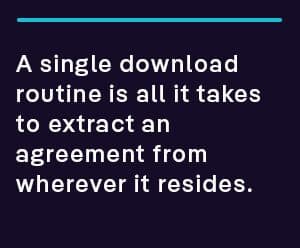Contract management processes are critical to any organization. It’s important to establish secure and seamless integrations between a company’s contract lifecycle management (CLM) platform and complementary on-premises and software as a service (SaaS) business applications, which are integral systems that run and monitor business functions such as:
- Human resources
- Sales and marketing
- Procurement
- Document authoring, approvals, translation, and file storage
- Analytics and reporting
- Electronic communications
- AI-powered systems
- Custom applications

Integrating your contract management solution with these types of digital platforms enables you to facilitate complete workflows, such as executive contract approvals or client sign-off. Triggering contract events and workflows from an application like Salesforce.com for sell-side agreements, or SAP Ariba for buy-side agreements can create efficiencies and enforce policy compliance.
Investing in a CLM platform that is interoperable with your existing and future business applications is important and offers valuable business benefits:
1. Greater Context for Reporting and Analytics
Contract metadata, such as client name, “authored by,” and create, expiry, and contract renewals, is crucial for effective reporting. Yet while metadata is measured by an analytics engine, contract managers and line of business executive managers often want to know why trends are happening in their business. For example, why are sales cycles and negotiation periods take longer than last year?
A smart contract management platform enables your users to access pre-configured reports and empowers them to create and schedule their own analysis of your CLM and integrated systems. Further, allow them to use the data visualization and reporting tools they are most comfortable with and accelerate user onboarding while improving the depth and breadth of your organization-wide data analysis.
2. Productivity Applications
Asking employees in legal, administrative, or sales roles to author or edit documents in an unfamiliar editor is time-consuming, disruptive, and counter-productive. Instead, implement a contract management system that integrates with familiar document creation tools Microsoft Word, Outlook, and Google Docs—to improve productivity.
3. Document File Storage
A centralized document repository is at the core of any enterprise-scale contract lifecycle management solution. Yet many businesses use other document collaboration platforms, such as SharePoint, Google Drive, Box, and Dropbox.
Synchronizing contacts and legal documents between platforms (ex: OneDrive and ContractPodAi) allows users to work in comfortable environments without frustration and time-consuming learning curves. When a user authors or updates a contract, they only need to upload it to their preferred file share platform, and the integration will automatically update the document in the ContractPodAi repository. Or vice versa.
A single download routine is all it takes to extract an agreement from wherever it resides.
4. Procurement Platforms
Not all contract management systems have the sophistication or digital flexibility to integrate with SAP Ariba, and Oracle. ContractPodAi does include proven connectivity with these platforms via its fully documented, RESTful API connector. Accelerating buy-side workflows to send fully-vetted contracts to a new supplier can save your procurement team valuable time and work. Pre-populate approved terms from your template library and send custom language or dollar value thresholds to your legal or executive designates.
5. Customer Relationship Management
Implementing, customizing, and configuring a company-wide CRM application for the way your sales, customer service, and marketing teams do business takes considerable effort from many different resources. Yet companies can quickly integrate their CRM and ERP platforms, such as Microsoft Dynamics 365 CRM with Dynamics 365 ERP, or Salesforce.com with Oracle.
Connecting your organization’s CRM and CLM solutions provides opportunities to increase salesperson productivity. It decreases administrative time so they can close deals and contribute to your business growth. For example, you can provide a button in your sales object in CRM to source a contract from your template library and populate it with client contact information and a configured price quote before sending it to a management approver, and ultimately, the negotiation partner. You can also enable privileged sales and operations employees to search your contract repository for active or archived contracts.
6. Electronic Signatures
Once you have established an electronic or digital signature service as your company standard, adopting compatible applications is important. Implementing a contract management platform that is compatible with Adobe, Signicat, and DocuSign integrations expedites the sign-off process by approvers on your clients’ executive management teams and moves your business relationships forward. Ensure your legal obligations, and that of your suppliers and service providers, have been fully vetted and approved.
Make Your Case for an Integrated, Innovative Contract Management Platform
If you want to drive efficiencies in your contract management processes, identify applications in your technology stack that initiate or complete contract workflows. Contract management integration can enhance productivity, accelerate negotiation cycles, and increase workflow efficiencies.
If you want to see how ContractPodAi fits into your existing tech stack, book your one-on-one demo today!









